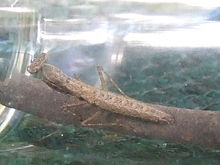
Hymenopus coronatus is a mantis from the tropical forests of Southeast Asia. It is known by various common names including walking flower mantis and (pink) orchid mantis. It is one of several species known as flower mantises from their resemblance and behaviour.
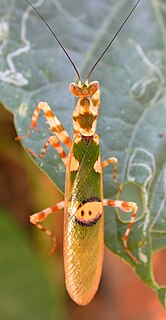
Creobroter is a genus of flower mantises in the tribe Hymenopodini; species are concentrated in Asia. The name comes from the Greek kreo-, meaning "flesh") and broter" meaning "eating", therefore, "flesh-eating", an apt name for a predatory insect. Both sexes have long wings and are capable fliers. Full-grown males are about 3 to 4 cm in length; females are about 4 to 5 cm.

Flower mantises are those species of praying mantises that mimic flowers. Their coloration is an example of aggressive mimicry, a form of camouflage in which a predator's colours and patterns lure prey. The flower mantises are not a natural group with a single ancestor, but most of the species are in the family Hymenopodidae. Their behaviours vary, but typically involve climbing a plant, and then staying still until a prey insect comes within range. Many species of flower mantises are popular as pets.

Orthodera ministralis, common name garden mantis or Australian green mantis, is a species of praying mantis from Australia. The garden mantis inhabits the whole of Australia, and can often be found hidden in leafy scrub from ground to eye level. It feeds on small insects by ambushing them.

Paraoxypilus is a genus of mantis, known as the boxer bark mantises. They are native to Australia and Oceania.

Sphodromantis viridis is a species of praying mantis that is kept worldwide as a pet. Its common names include African mantis, giant African mantis, and bush mantis.
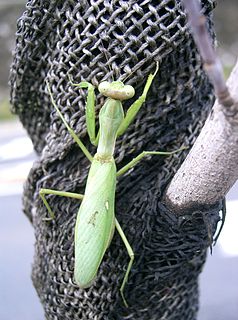
Hierodula patellifera, common name giant Asian mantis, Asian mantis, Indochina mantis or Harabiro Mantis, is a species of praying mantis belonging to genus Hierodula.

Bolbe pygmaea is a species of praying mantis in the family Nanomantidae. It is endemic to Australia.
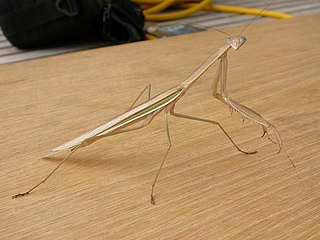
Tenodera australasiae, the purple-winged mantis, is species of praying mantis. Found in Australia, it is common in most parts of Brisbane (QLD). Both males and females are capable of flight. The species has not been shown to be parthenogenetic.
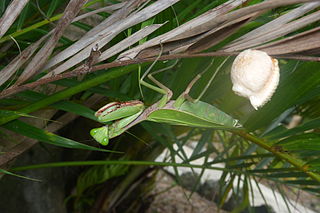
Hierodula majuscula is a species of praying mantis in the genus Hierodula. It is also known as the giant rainforest mantis and the Australian giant mantis. It is found in coastal northern Australia, usually in rainforest and adjacent habitats. This species is typically green although a less common bright yellow form does occur.
Bolbe lowi is a species of praying mantis in the family Nanomantidae. It is endemic to Australia
Bolbe maia is a species of praying mantis in the family Nanomantidae. It is endemic to Australia.
Bolbe nigra is a species of praying mantis in the family Nanomantidae. It is endemic to Australia.
Bolbe pallida is a species of praying mantis in the family Nanomantidae. It is endemic to Australia.
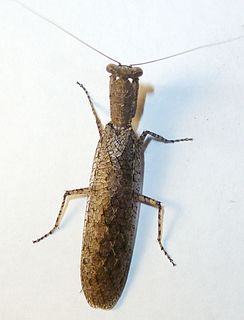
The bark mantises and ground mantises are praying mantids now placed in the family Eremiaphilidae that are native to the Afrotropics. They are generally light brown but more silvery on the wings. The wings are attractively reticulated, and the veins may be mottled dark and pale. The head is wider than the pronotum, which is rounded anteriorly, and doesn't overlap with the rear of the head. The pronotum is depressed, with its sides more or less parallel, and only a weak supra-coxal bulge is present. The anterior tibia are flattened and greatly expanded longitudinally, and the tibial claw does not fit into a pit between the 1st and 2nd external spines of the anterior femora, as in a few mantis groups.

Mantises are an order (Mantodea) of insects that contains over 2,400 species in about 460 genera in 33 families. The largest family is the Mantidae ("mantids"). Mantises are distributed worldwide in temperate and tropical habitats. They have triangular heads with bulging eyes supported on flexible necks. Their elongated bodies may or may not have wings, but all Mantodea have forelegs that are greatly enlarged and adapted for catching and gripping prey; their upright posture, while remaining stationary with forearms folded, has led to the common name praying mantis.

Statilia is a genus of praying mantis that resembles dead or living grass. Statilia species live in Australia, Africa, Asia and islands.
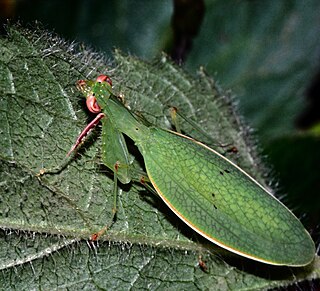
The Nanomantidae are a new (2019) family of praying mantises, based on the type genus Nanomantis. As part of a major revision of mantid taxonomy, genera and tribes have been moved here, substantially replacing the old family Iridopterygidae.
